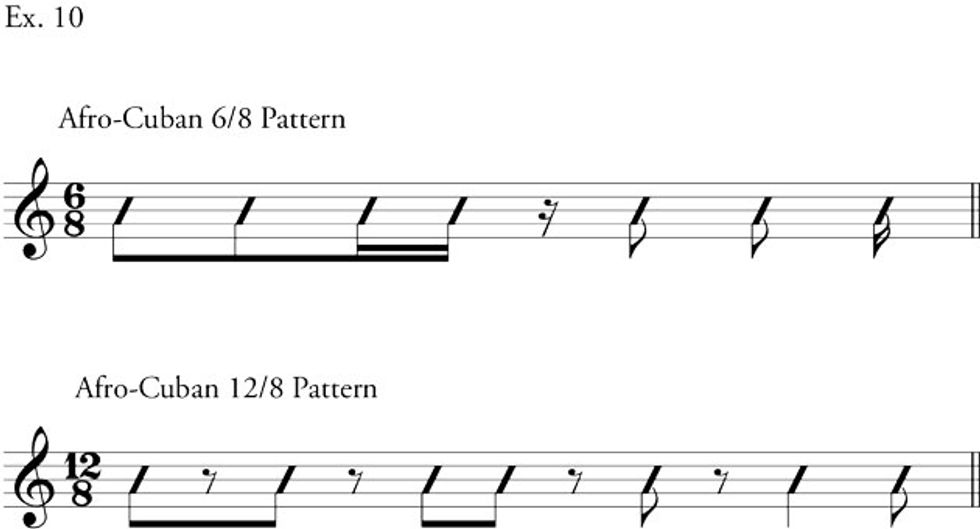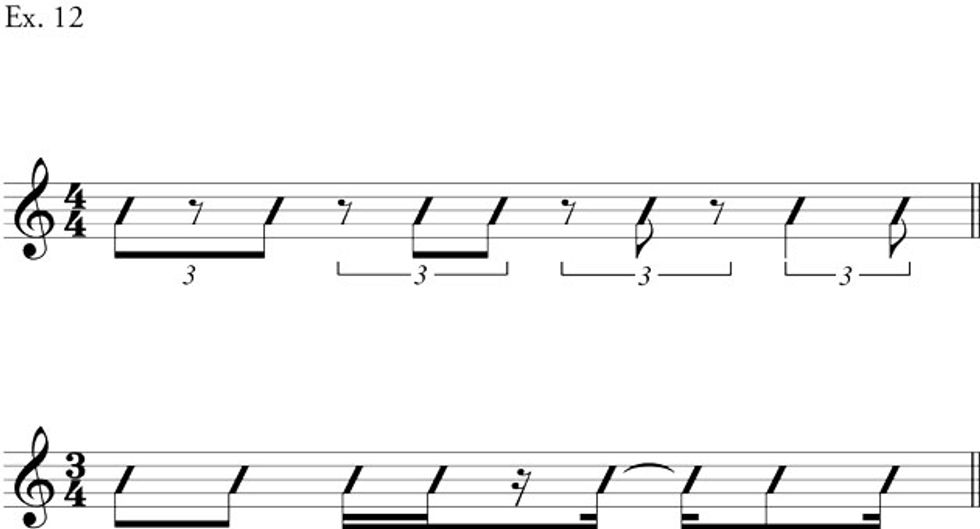Theory: Intermediate
Lesson Overview:
• Understand the elements of polyrhythms.
• Learn how to subdivide in different time signatures.
• Create more rhythmically interesting lines. Click here to download a printable PDF of this lesson's notation.
Have you ever started listening to the intro of a tune only to realize you’ve been “tricked” as soon as the rest of the band enters? You thought you knew the beat, but then the drums just proved that you needed more information. You’d been dancing all wrong in your head. Sometimes, finding the “one” is really difficult if you initially had a different rhythmic perception. Then again, all it would likely take is for you to back up and hear it again—just with counting this time.
Imagine playing with a great drummer and they are in the middle of an exciting solo where anything could happen. If you don’t pay really close attention, you might get turned around. What do you do?
What if you worked out some super-cool shred lick using 16th-notes, but then find yourself in a situation where you try to play it starting on a different beat, or in a different time signature, or maybe in a different feel, only to realize you really don’t know the lick like you thought you did?
These, in my opinion, are the most fun aspects of playing music. Things can shift and I love it! But to feel comfortable with more time options it may require a deeper look at time and how to practice it. Working on time-feel, groove, and rhythmic perception is often more learned than taught. In this lesson we will explore how polyrhythms can improve your time, but first, here are a few things that have helped me:
- Working on polyrhythms to help calibrate your eighth-notes, triplets, or 16th-notes.
- Using different word phrases in polyrhythms to help shift the rhythmic perception.
- Using movement with music (“eurhythmics”).
- Exploring the options in the Afro-Cuban 6/8 pattern (Abakuá or Abaquá clave).
- Practicing musical phrases, licks, or arpeggios with different rhythmic options.
Polyrhythms are more than just an awesome party trick. They are actually very helpful in improving your feel and make sure that all the “little beats” line up exactly right. Control of your time-feel is one of the most important aspects of musicianship.
I prefer to work on technique in the context of time-feel exercises. If you can’t physically hit that note or chord exactly when you want it to be played, your audience will think you have bad time and will literally (or figuratively) leave the dance floor.
Learn this little eight-note technical exercise (Ex. 1) and we’ll go from there. You can play it as eighth-notes or 16th-notes. Notice it really works out the weakest finger (the pinky) the most, so there’s a little bonus.
Click here for Ex. 1
Next, take that same exercise but play it as triplets (Ex. 2). It’ll be tough at first because it’s an eight-note pattern and you’ll have to play it through three times to complete the cycle. You may have to play through Ex. 1 a million times to be able to play it instinctively enough to try it in this new and different way. To get it to sound like triplets, make sure you accent the first note of every group of three. If you alternate pick, the accents will alternate between downstrokes and upstrokes.
Click here for Ex. 2
The previous exercise points out an interesting phenomenon: Certain aspects of your playing will need to be practiced exhaustively so that it goes into your subconscious. Almost like a reflex action, developing the ability to do it without using your cerebral cortex so that your conscious thought is freed up to do other things.
Look at these two different ways of playing a 3:2 polyrhythm. Ex. 3 (the “Jack Nicholson” one) is in a “compound duple” meter (6/8) and the accents are clearly “1–2–3–4–5–6” with a straight 16th-note subdivision. You can try this on guitar, drums or whatever. For now, try this tapping on your knees and play the top-line rhythm with your right hand and the bottom-line rhythm with the left hand. With the “Jack Nicholson Eats Broccoli” phrase in mind, notice how your conscious thought will gravitate towards the right hand. These are the main accents and will tell your body how to dance. This consciousness will create the accents.
Click here for Ex. 3
Next, see if you can continue with the same knee-slapping pattern but now play the Ex. 4. Notice how it’s the same rhythm, but your conscious thought is now on the left hand, the duple rhythm. You are now in a “simple duple” meter with a triplet subdivision. Notice how the in-between notes are not evenly placed between the accents. Your conscious thought is now on the main accents played with your left hand. It’s the same rhythm but a different dance because you shift your weight differently. Your consciousness has shifted causing a shift in how you move to the beat. These two patterns show a difference in rhythmic perception.
Click here for Ex. 4
For another example of a rhythmic perception contrast, try these next two. They are more complicated polyrhythms: 3:4 and 4:3. Ex. 5 (“Pass the Stupid Butter”) feels like a straight 16th-note rhythm in 3/4 with perfectly placed subdivisions. One way to feel this is as a funk with the backbeat on three.
Click here for Ex. 5
Ex. 6 (“No Yelling on the Bus!”) once again has the exact same distances between the notes but your consciousness is now on the other hand. There are now different accents, a different rhythmic perception, and a different dance. It’s now a 4/4 meter with a triplet feel.
Click here for Ex. 6
To explore this 3:4 vs 4:3 distinction even more, check out Ex. 7. It’s an arpeggio pattern that I love to practice. It has 24 notes, so you can change the feel between two measures of 16th-notes in 3/4 or two measures of triplets in 4/4 (Ex. 8). Going back and forth requires a shift in your accents and conscious thought. I have it here as a sweeping exercise using some barring with the pinky—again, trying to work out that weakest link. If you’ve become comfortable with one way of feeling the pattern, the other feel will feel surprisingly different—even though the order of notes is the same. You have to aim for different notes. A different dance.
Click here for Ex. 7
Click here for Ex. 8
Try recording it into a looper pedal in one time feel and then comp with yourself in the other time feel just to see how accurate your micro-time is.
This talk about “dance” is also an interesting study. The practice of learning rhythms with movement in formal music education has been done (look up “eurythmics”), but in many African and Latin American cultures, the dance is inseparable from the music. It’s often the dance that tells your ear what’s going on.
One of my favorite rhythms that illustrates this concept is the Afro-Cuban 6/8 (also known as the Afro-Cuban 6/4, or Afro-Cuban 12/8, or Abakuá clave, or Abaquá clave). One thing I love about it is that it doesn’t spoon-feed you the backbeat. It’s not obvious to the Western ear exactly how to dance to it or how to hear where the main accents are. It’s almost like you have to dance to it to hear it properly.
There are many variations, but Ex. 9 shows one common version.
In that version, the downbeat is on beat 1 and the backbeat is on beat 4. Notice how there’s a gap (a rest) on that backbeat? Cool, right? That’s one of the ingredients of syncopation.
Here’s that same rhythm written in 6/8 or 12/8 (Ex. 10).
C
Now, let’s use the rhythm to make some actual music. In Ex. 11, I combined this rhythm with a relatively simple chord progression over an A bass note.
Click here for Ex. 11
Another thing I love about the Afro-Cuban 6/8 rhythm is that you can use it to pivot to other time feels. The same pattern can be “danced to” differently, for a different rhythmic perception. In Ex. 12 you can see how it looks in 4/4 and 3/4.
If it’s felt in 4/4, it dances with a swing feel or a shuffle. Check out how jazz drummer Elvin Jones plays a medium swing on “Speak No Evil.” You can hear the Afro-Cuban 6/8 rhythm in his comping and his fills.
If it’s felt in 3/4 it can feel like a funk rhythm. The backbeat would be dancing on beat 3. Incidentally, the 4/4 example (Ex. 13) will remind you of the “No Yelling on the Bus!” polyrhythm and the 3/4 example (Ex. 14) has shades of “Pass the Stupid Butter.”
Click here for Ex. 13
Click here for Ex. 14
For an even deeper study, the next three examples show how you can imply different subdivisions within new pulses. In Ex. 15, I am playing the rhythm in 4/4, but moving the subdivisions from eighth-note triplets to simple eighth-notes.
Click here for Ex. 15
In Ex. 16, we’re staying in 4/4, but the subdivisions go from eighth-note triplets to 16th-notes.
Click here for Ex. 16
Finally, in Ex. 17 we hit that funky 3/4 rhythm with 16th-note and eighth-note triplet subdivisions.
Click here for Ex. 17
This shift in rhythmic perception and subdivisions is one of the essential ingredients in understanding the concept of metric modulation. You can take the same rhythm perceived as eighth-note triplets and again as 16th-notes and you get a shift in how the phrase is felt. To drive this point home, take this random collection of random subdivisions (Ex. 18).
That pattern of 48(!) subdivisions seems pretty ridiculous to read, right? Let’s arrange those subdivisions into smaller, bite-size chunks and add some barlines. Since there are 48 subdivisions, we can arrange it in a number of ways:
1. Four measures of 12 subdivisions each felt in 4/4 (four measures of 12/8 or 4/4 with triplets)
2. Four measures of 12 subdivisions felt in 3/4 (four measures of 3/4 with a 16th-note subdivision)
3. Three measures of 4/4 with a 16th-note subdivision
In Ex. 19 I’ve taken that same rhythmic pattern and created a funky lick over E7 using triplets.
Click here for Ex. 19
Finally, in Ex. 20, I use the same rhythm over three measures of 4/4 using 16th-notes.
Click here for Ex. 20
As you can see, there are multiple ways you can practice this stuff to give your ideas more rhythmic interest and variation. Any idea should be adaptable to multiple time feels and even musical styles. Try taking some of your favorite licks and work them out using a different subdivision. They will seem like completely different licks at first, but eventually this way of rhythmically adapting your ideas will come easier.














![Rig Rundown: Russian Circles’ Mike Sullivan [2025]](https://www.premierguitar.com/media-library/youtube.jpg?id=62303631&width=1245&height=700&quality=70&coordinates=0%2C0%2C0%2C0)



![Rig Rundown: AFI [2025]](https://www.premierguitar.com/media-library/youtube.jpg?id=62064741&width=1245&height=700&quality=70&coordinates=0%2C0%2C0%2C0)



